Effect of Cucurbit[7]uril on Adsorption of Aniline Derivatives at Quartz
Abstract
:1. Introduction
2. Experimental
2.1. Material

2.2. The Study of NMR Titration
2.3. The Study of UV-Vis Spectrometry
2.4. The Study of Quartz Crystal Microbalance with Dissipation
2.5. The Characterization of Atomic Force Microscopy
3. Results and Discussion
3.1. The Host-Guest Interaction between Q[7] and Benzidine
3.2. The Host–Guest Interaction between Q[7] and 4,4′-Diaminodiphenylmethane
3.3. The Adsorption of Benzidine at Quartz
3.4. The Adsorption of MDA on Quartz
4. Conclusions
Author Contributions
Funding
Institutional Review Board Statement
Informed Consent Statement
Data Availability Statement
Conflicts of Interest
References
- Sáenz-Pérez, M.; Lizundia, E.; Laza, J.M.; García-Barrasa, J.; Vilas, J.L.; León, L.M. Methylene Diphenyl Diisocyanate (Mdi) and Toluene Diisocyanate (Tdi) Based Polyurethanes: Thermal, Shape-Memory and Mechanical Behavior. RSC Adv. 2016, 6, 69094–69102. [Google Scholar] [CrossRef]
- Maleki, R.; Koukabi, N.; Kolvari, E. Fe3O4-Methylene Diphenyl Diisocyanate-Guanidine (Fe3O4–4,4′-Mdi-Gn): A Novel Superparamagnetic Powerful Basic and Recyclable Nanocatalyst as an Efficient Heterogeneous Catalyst for the Knoevenagel Condensation and Tandem Knoevenagel-Michael-Cyclocondensation Reactions. Appl. Organomet. Chem. 2018, 32, 3905–3915. [Google Scholar] [CrossRef]
- Travis, A.S. Poisoned Groundwater and Contaminated Soil: The Tribulations and Trial of the First Major Manufacturer of Aniline Dyes in Basel. Environ. Hist. 1997, 2, 343–365. [Google Scholar] [CrossRef]
- Grenner, A.; Klauck, M.; Meinhardt, R.; Schumann, R.; Schmelzer, J. Ternary Liquid−Liquid(−Liquid) Equilibria of Aniline + Cyclohexylamine + Water, Aniline + Cyclohexylamine + Octane, Aniline + Water + Toluene, and Aniline + Water + Octane. J. Chem. Eng. Data 2006, 51, 1009–1014. [Google Scholar] [CrossRef]
- Ganesh, V.; Noble, A.; Aggarwal, V.K. Chiral Aniline Synthesis Via Stereospecific C(Sp3)–C(Sp2) Coupling of Boronic Esters with Aryl Hydrazines. Org. Lett. 2018, 20, 6144–6147. [Google Scholar] [CrossRef]
- Schwarze, T.; Schneider, R.; Riemer, J.; Holdt, P.D.H.-J. A Highly K+-Selective Fluorescent Probe—Tuning the K+-Complex Stability and the K+/Na+ Selectivity by Varying the Lariat-Alkoxy Unit of a Phenylaza[18]Crown-6 Ionophore. Chem.—Asian J. 2016, 11, 241–247. [Google Scholar] [CrossRef]
- Singh, G.; Singh, J.; Mangat, S.S.; Arora, A. Three-Step Pathway Towards Bis(1,2,3-Triazolyl-Γ-Propylsilatranes) as Cu2+ Fluorescent Sensor, Via ‘Click Silylation’. Tetrahedron Lett. 2014, 55, 2551–2558. [Google Scholar] [CrossRef]
- Skipper, P.; Kim, M.; Sun, P.; Wogan, G.; Tannenbaum, S. Monocyclic Aromatic Amines as Potential Human Carcinogens: Old Is New Again. Carcinogenesis 2009, 31, 50–58. [Google Scholar] [CrossRef] [Green Version]
- Cocaign, A.; Bui, L.-C.; Silar, P.; Chan Ho Tong, L.; Busi, F.; Lamouri, A.; Mougin, C.; Rodrigues-Lima, F.; Dupret, J.-M.; Dairou, J. Biotransformation of Trichoderma Spp and Their Tolerance to Aromatic Amines, a Major Class of Pollutants. Appl. Environ. Microbiol. 2013, 79, 4719–4726. [Google Scholar] [CrossRef] [Green Version]
- Mujahid, M.; Prasuna, M.L.; Sasikala, C.; Ramana, C.V. Integrated Metabolomic and Proteomic Analysis Reveals Systemic Responses of Rubrivivax Benzoatilyticus Ja2 to Aniline Stress. J. Proteome Res. 2015, 14, 711–727. [Google Scholar] [CrossRef]
- Yi, Z.; Chen, L.; Ren, Y.; Li, Y.; Liu, Z.; Wu, J.; Zhu, A. Decontamination of Aniline and Malathion on Material Surface by Array Cold Atmospheric Pressure Plasma Jet: Mechanism and Decontamination Pathways. J. Environ. Chem. Eng. 2022, 10, 107383–107392. [Google Scholar] [CrossRef]
- Thakur, S.; Qanungo, K. Removal of Aniline Blue from Aqueous Solution Using Adsorption: A Mini Review. Mater. Today Proc. 2021, 37, 2290–2293. [Google Scholar] [CrossRef]
- Shao, M.; Li, Y.; Meng, L.; Guo, J.; Gao, Y.; Liu, Y.; Huang, M. Simultaneous Removal of Antimony, Chromium and Aniline by Forward Osmosis Membrane: Preparation, Performance and Mechanism. Desalination 2021, 520, 115363–115372. [Google Scholar] [CrossRef]
- Viayna, A.; Ghashghaei, O.; Vílchez, D.; Estarellas, C.; López, M.; Gómez-Catalán, J.; Lavilla, R.; Delgado, J.; Luque, F.J. Holistic Approach to Anti-Knock Agents: A High-Throughput Screening of Aniline-Like Compounds. Fuel 2021, 305, 121518–121526. [Google Scholar] [CrossRef]
- Sang, W.; Cui, J.; Feng, Y.; Mei, L.; Zhang, Q.; Li, D.; Zhang, W. Degradation of Aniline in Aqueous Solution by Dielectric Barrier Discharge Plasma: Mechanism and Degradation Pathways. Chemosphere 2019, 223, 416–424. [Google Scholar] [CrossRef]
- Pang, S.-Y.; Duan, J.-B.; Zhou, Y.; Gao, Y.; Jiang, J. Oxidation Kinetics of Anilines by Aqueous Permanganate and Effects of Manganese Products: Comparison to Phenols. Chemosphere 2019, 235, 104–112. [Google Scholar] [CrossRef]
- Liu, H.; Lin, H.; Song, B.; Sun, X.; Xu, R.; Kong, T.; Xu, F.; Li, B.; Sun, W. Stable-Isotope Probing Coupled with High-Throughput Sequencing Reveals Bacterial Taxa Capable of Degrading Aniline at Three Contaminated Sites with Contrasting Ph. Sci. Total Environ. 2021, 771, 144807–144816. [Google Scholar] [CrossRef]
- Assaf, K.I.; Abed Alfattah, H.; Eftaiha, A.A.; Bardaweel, S.K.; Alnajjar, M.A.; Alsoubani, F.A.; Qaroush, A.K.; El-Barghouthi, M.I.; Nau, W.M. Encapsulation of Ionic Liquids inside Cucurbiturils Electronic Supplementary Information (Esi) Available: Additional Nmr Data, Itc and Dye Displacement Experiments, Computational Results, Conductivity and Anti-Cancer Activity Results. Org. Biomol. Chem. 2020, 18, 2120–2128. [Google Scholar] [CrossRef]
- Máximo, P.; Colaço, M.; Pauleta, S.R.; Costa, P.J.; Pischel, U.; Parola, A.J.; Basílio, N. Photomodulation of Ultrastable Host–Guest Complexes in Water and Their Application in Light-Controlled Steroid Release. Org. Chem. Front. 2022. [Google Scholar] [CrossRef]
- Miskolczy, Z.; Megyesi, M.; Sinn, S.; Biedermann, F.; Biczók, L. Simultaneous Analyte Indicator Binding Assay (Sba) for the Monitoring of Reversible Host–Guest Complexation Kinetics. Chem. Commun. 2021, 57, 12663–12666. [Google Scholar] [CrossRef]
- Freitag, M.; Galoppini, E. Cucurbituril Complexes of Viologens Bound to TiO2 Films. Langmuir 2010, 26, 8262–8269. [Google Scholar] [CrossRef]
- Kim, J.; Jung, I.-S.; Kim, S.-Y.; Lee, E.; Kang, J.-K.; Sakamoto, S.; Yamaguchi, K.; Kim, K. New Cucurbituril Homologues: Syntheses, Isolation, Characterization, and X-Ray Crystal Structures of Cucurbit[N]Uril (N = 5, 7, and 8). J. Am. Chem. Soc. 2000, 122, 540–541. [Google Scholar] [CrossRef]
- Lin, R.-L.; Dong, Y.-P.; Tang, M.; Liu, Z.; Tao, Z.; Liu, J.-X. Selective Recovery and Detection of Gold with Cucurbit[N]Urils (N = 5–7). Inorg. Chem. 2020, 59, 3850–3855. [Google Scholar] [CrossRef]
- Thomas, S.S.; Tang, H.; Bohne, C. Noninnocent Role of Na+ Ions in the Binding of the N-Phenyl-2-Naphthylammonium Cation as a Ditopic Guest with Cucurbit[7]Uril. J. Am. Chem. Soc. 2019, 141, 9645–9654. [Google Scholar] [CrossRef]
- Ivanov, D.A.; Petrov, N.K.; Nikitina, E.A.; Basilevsky, M.V.; Vedernikov, A.I.; Gromov, S.P.; Alfimov, M.V. The 1:1 Host−Guest Complexation between Cucurbit[7]Uril and Styryl Dye. J. Phys. Chem. A 2011, 115, 4505–4510. [Google Scholar] [CrossRef]
- Gan, L.X.; Hao, C.L.; Jiang, X.M. Controllable Adsorption and Desorption of a Cationic Surfactant at Quartz Directed by Host-Guest Complex. Colloids Surf. A Physicochem. Eng. Asp. 2021, 625, 126880. [Google Scholar] [CrossRef]
- Kataki-Anastasakou, A.; Axtell, J.C.; Hernandez, S.; Dziedzic, R.M.; Balaich, G.J.; Rheingold, A.L.; Spokoyny, A.M.; Sletten, E.M. Carborane Guests for Cucurbit[7]Uril Facilitate Strong Binding and on-Demand Removal. J. Am. Chem. Soc. 2020, 142, 20513–20518. [Google Scholar] [CrossRef]
- Monemian Esfahani, A.; Zhao, W.; Chen, J.Y.; Huang, C.; Xi, N.; Xi, J.; Yang, R. On the Measurement of Energy Dissipation of Adhered Cells with the Quartz Microbalance with Dissipation Monitoring. Anal. Chem. 2018, 90, 10340–10349. [Google Scholar] [CrossRef]
- Tanoue, H.; Yamada, N.L.; Ito, K.; Yokoyama, H. Quantitative Analysis of Polymer Brush Formation Kinetics Using Quartz Crystal Microbalance: Viscoelasticity of Polymer Brush. Langmuir 2017, 33, 5166–5172. [Google Scholar] [CrossRef]
- Largitte, L.; Pasquier, R. A Review of the Kinetics Adsorption Models and Their Application to the Adsorption of Lead by an Activated Carbon. Chem. Eng. Res. Des. 2016, 109, 495–504. [Google Scholar] [CrossRef]
- Kolman, K.; Makowski, M.M.; Golriz, A.A.; Kappl, M.; Pigłowski, J.; Butt, H.-J.; Kiersnowski, A. Adsorption, Aggregation, and Desorption of Proteins on Smectite Particles. Langmuir ACS J. Surf. Colloids 2014, 30, 11650–11659. [Google Scholar] [CrossRef] [PubMed]
- Sut, T.N.; Jackman, J.A.; Cho, N.-J. Understanding How Membrane Surface Charge Influences Lipid Bicelle Adsorption onto Oxide Surfaces. Langmuir ACS J. Surf. Colloids 2019, 35, 8436–8444. [Google Scholar] [CrossRef] [PubMed]
- Li, J.; Piehler, L.T.; Qin, D.; Baker, J.R.; Tomalia, D.A.; Meier, D.J. Visualization and Characterization of Poly(Amidoamine) Dendrimers by Atomic Force Microscopy. Langmuir 2000, 16, 5613–5616. [Google Scholar] [CrossRef]
- Hierlemann, A.; Campbell, J.K.; Baker, L.A.; Crooks, R.M.; Ricco, A.J. Structural Distortion of Dendrimers on Gold Surfaces: A Tapping-Mode Afm Investigation. J. Am. Chem. Soc. 1998, 120, 5323–5324. [Google Scholar] [CrossRef]
- Tsukruk, V.V. Dendritic Macromolecules at Interfaces. Adv. Mater. 1998, 10, 253–257. [Google Scholar] [CrossRef]
- Li, J.; Qin, D.; Baker, J.; Tomalia, D. The Characterization of High Generation Poly(Amidoamine) G9 Dendrimers by Atomic Force Microscopy (Afm). Macromol. Symp. 2001, 167, 257–269. [Google Scholar] [CrossRef]
- Betley, T.A.; Hessler, J.A.; Mecke, A.; Banaszak Holl, M.M.; Orr, B.G.; Uppuluri, S.; Tomalia, D.A.; Baker, J.R. Tapping Mode Atomic Force Microscopy Investigation of Poly(Amidoamine) Core−Shell Tecto(Dendrimers) Using Carbon Nanoprobes. Langmuir 2002, 18, 3127–3133. [Google Scholar] [CrossRef]
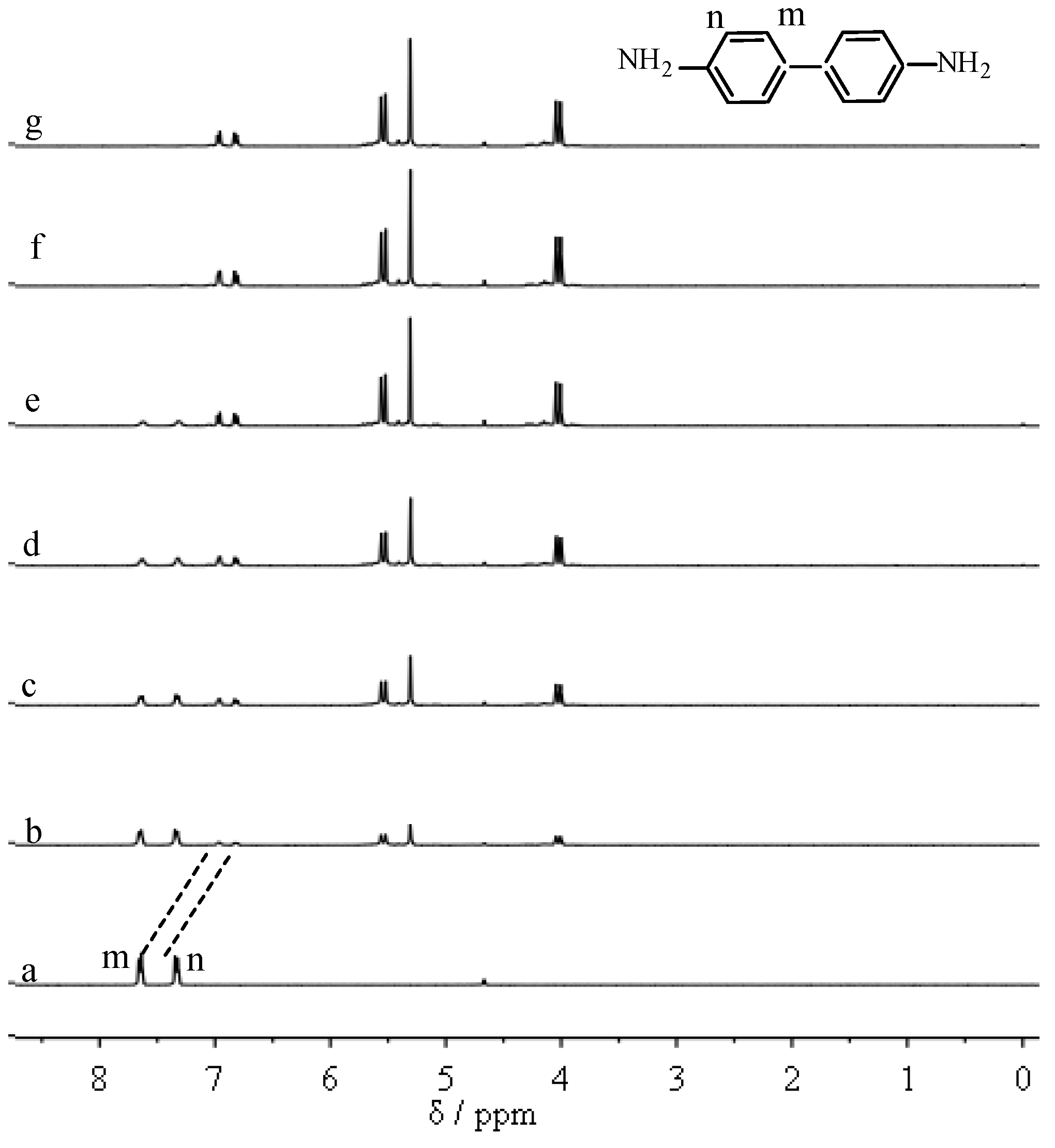


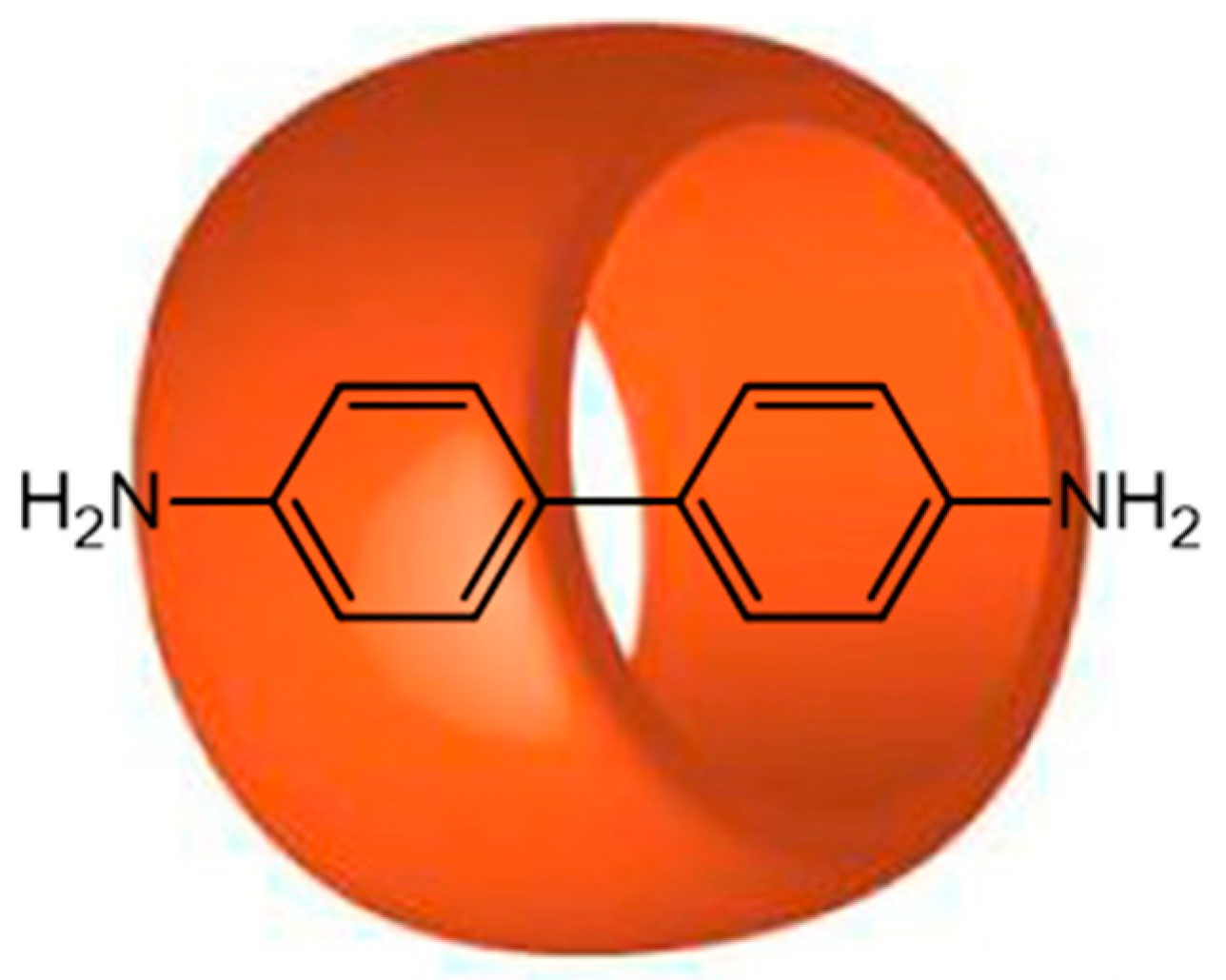
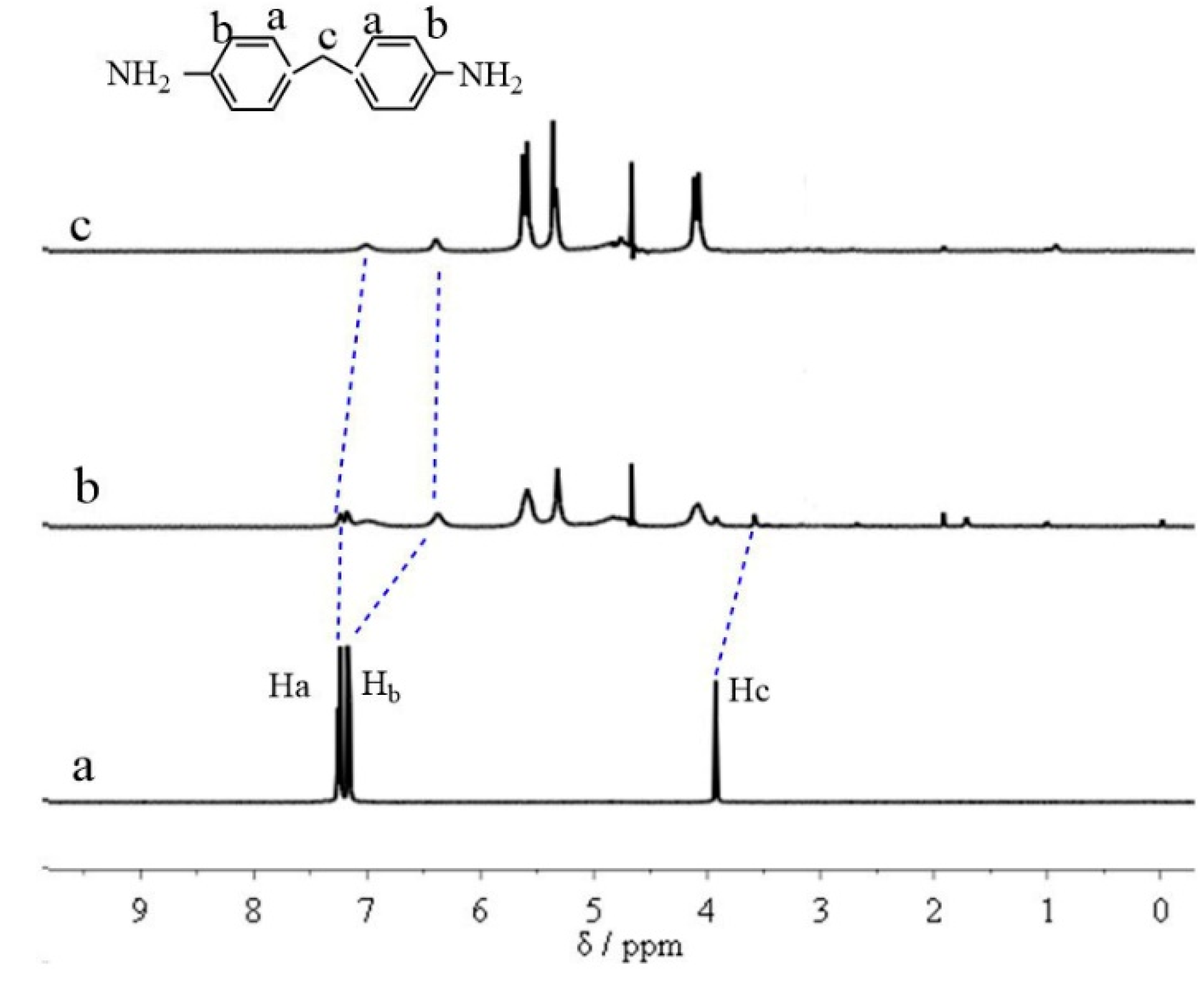

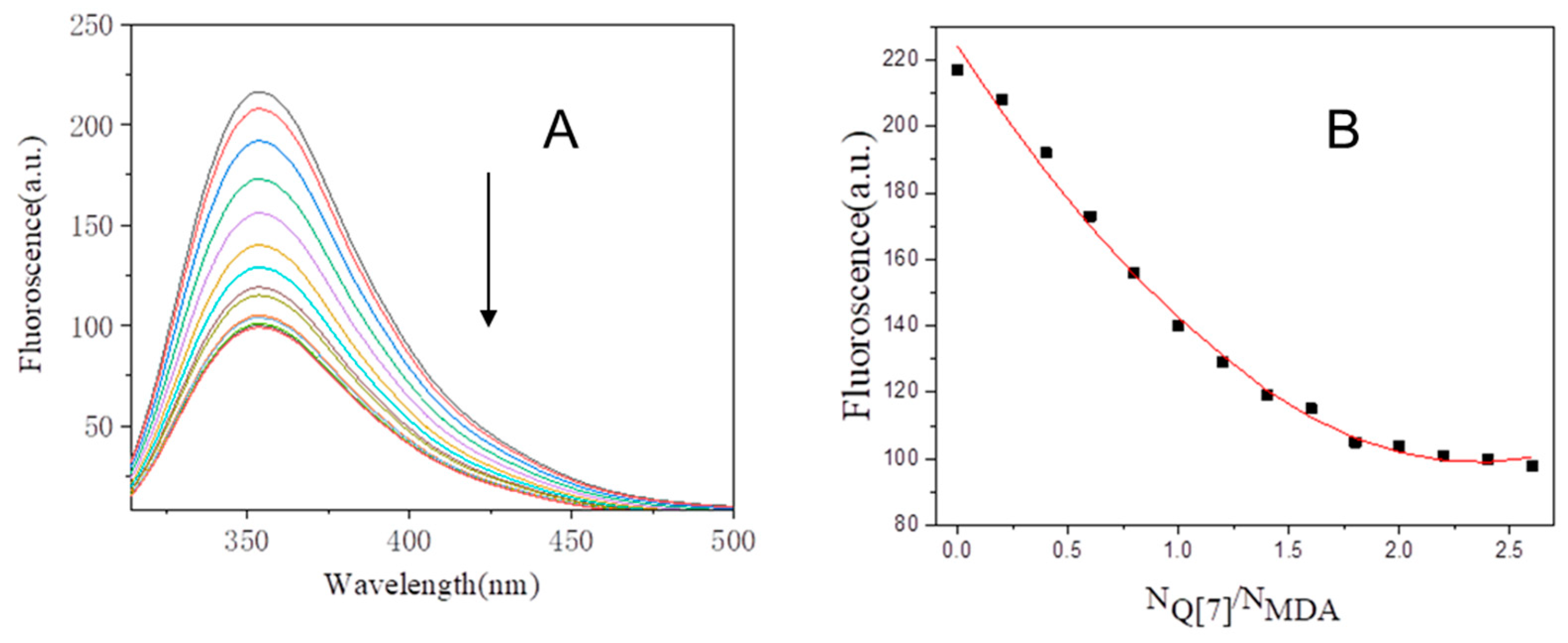

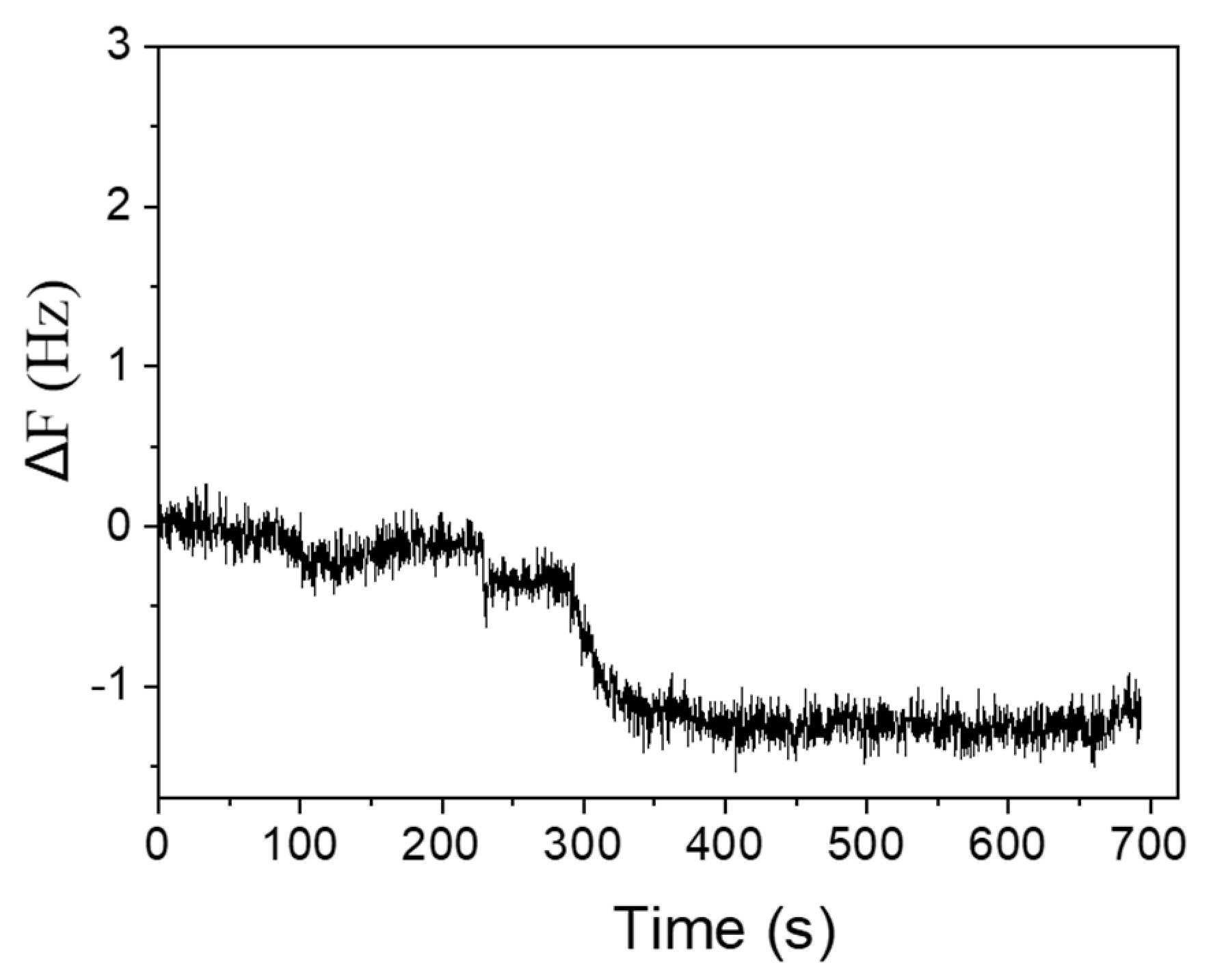
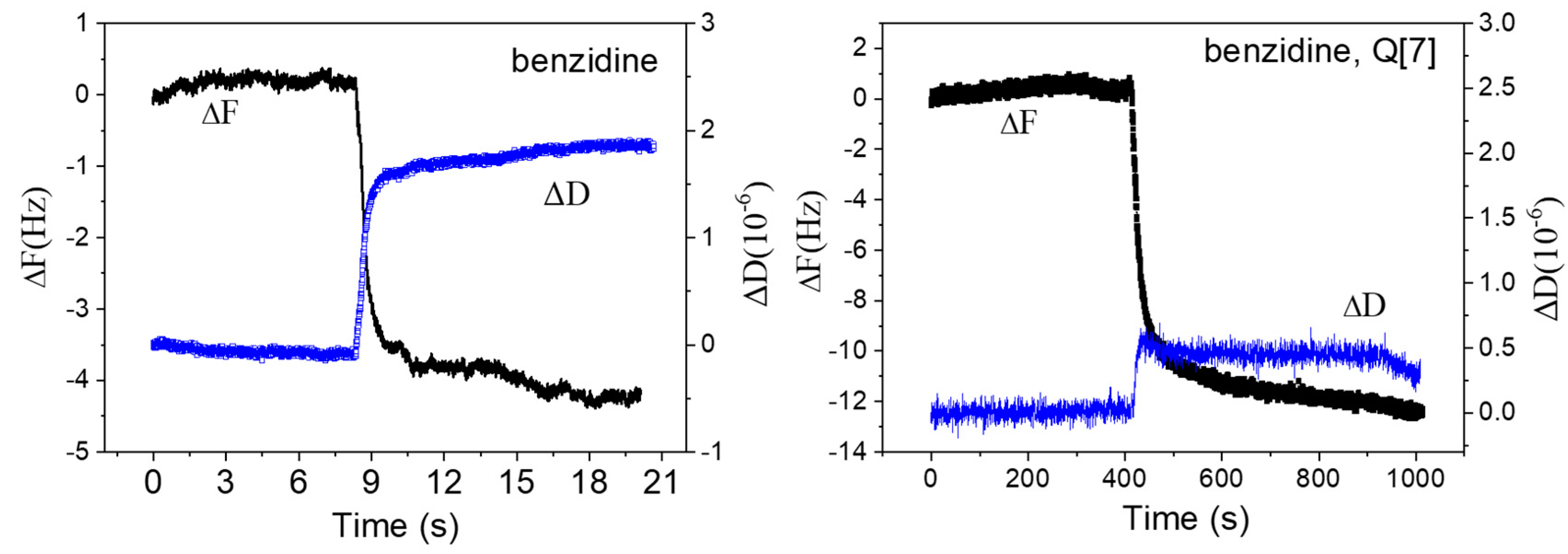



Publisher’s Note: MDPI stays neutral with regard to jurisdictional claims in published maps and institutional affiliations. |
© 2022 by the authors. Licensee MDPI, Basel, Switzerland. This article is an open access article distributed under the terms and conditions of the Creative Commons Attribution (CC BY) license (https://creativecommons.org/licenses/by/4.0/).
Share and Cite
Wang, K.; Jiang, X.; Hao, C.; Tao, Z. Effect of Cucurbit[7]uril on Adsorption of Aniline Derivatives at Quartz. Coatings 2022, 12, 1100. https://doi.org/10.3390/coatings12081100
Wang K, Jiang X, Hao C, Tao Z. Effect of Cucurbit[7]uril on Adsorption of Aniline Derivatives at Quartz. Coatings. 2022; 12(8):1100. https://doi.org/10.3390/coatings12081100
Chicago/Turabian StyleWang, Kui, Xiaoming Jiang, Chunling Hao, and Zhu Tao. 2022. "Effect of Cucurbit[7]uril on Adsorption of Aniline Derivatives at Quartz" Coatings 12, no. 8: 1100. https://doi.org/10.3390/coatings12081100





